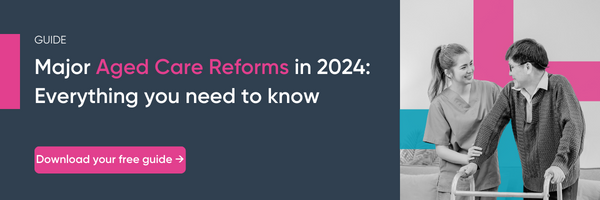New “strengthened” Aged Care Quality Standards commence on 1 July 2024, bringing with them some new requirements for aged care providers. Today we look at the requirements that will apply with regard to end-of-life care.
Note: aged care providers must continue to abide by the current Aged Care Quality Standards until the strengthened Standards are introduced in July 2024.
Overview: Key Differences Between the Current and New Standards
- The new Standards will consolidate all end-of-life care requirements into one Standard.
- The new Standards are significantly more detailed than the current ones. While the current Standards express end-of-life care requirements as two broad statements, the new Standards will delineate end-of-life requirements via one “Outcome statement” and a list of 17 specific actions that providers must undertake.
What the Current Standards Say
The current Standards address end-of-life care across two separate Standards (Standard 2: Ongoing Assessment and Planning, and Standard 3: Personal and Clinical Care).
Standard 2: Ongoing Assessment and Planning, requirement (3)(b)
“Assessment and planning identifies and addresses the consumer’s current needs, goals and preferences, including advance care planning and end of life planning if the consumer wishes.”
Standard 3: Personal and Clinical Care, requirement (3)(c)
“The needs, goals and preferences of consumers nearing the end of life are recognised and addressed, their comfort maximised and their dignity preserved.”
What the New Strengthened Standards Say
The new Standards will consolidate all end-of-life care requirements under a single Standard, “Standard 5: Clinical Care”. Within this Standard, end-of-life care will have its own section called “5.7: Palliative Care and End-of-Life Care”. That section will include an outcome statement and actions:
Outcome statement:
The older person’s needs, goals and preferences for palliative care and end-of-life care are recognised and addressed and their dignity is preserved. The older person’s pain and symptoms are actively managed with access to specialist palliative and end-of-life care when required, and their family and carers are informed and supported, including during the last days of life.
Actions:
5.7.1 The provider has processes to recognise when the older person requires palliative care or is approaching the end of their life, supports them to prepare for the end-of-life and responds to their changing needs and preferences.
5.7.2 The provider supports the older person, their family, carers and substitute decision maker, to:
- continue end-of-life planning conversations
- discuss requesting or declining aspects of personal care, life-prolonging treatment and responding to reversible acute conditions
- review advance care planning documents to align with their current needs, goals and preferences.
5.7.3 The provider uses its processes from comprehensive care to plan and deliver palliative care that:
- prioritises the comfort and dignity of the older person
- supports the older person’s spiritual, cultural, and psychosocial needs
- identifies and manages changes in pain and symptoms
- provides timely access to specialist equipment and medicines for pain and symptom management
- communicates information about the older person’s preferences for palliative care and the place where they wish to receive this care to workers, their carers, family and others
- facilitates access to specialist palliative care and end-of-life health professionals when required
- provides a suitable environment for palliative care
- provides information about the process when a person is dying and about loss and bereavement to family and carers.
5.7.4 The provider implements processes in the last days of life to:
- recognise that the older person is in the last days of life and respond to rapidly changing needs
- ensure medicines to manage pain and symptoms, including anticipatory medicines, are prescribed, administered, reviewed and available 24-hours a day
- provide pressure care, oral care, eye care and bowel and bladder care
- recognise and respond to delirium
- minimise unnecessary transfer to hospital, where this is in line with the older person’s preferences.

What Providers Need to Do
In preparation for the new end-of-life requirements in the upcoming Standards, providers should audit their end-of-life policies against the actions listed in 5.7 and ask themselves:
- What processes do we have in place to recognise when an older person is approaching the end of their life?
- What processes do we have in place to take account of the older person’s needs and preferences?
- Providers are required to check in regularly about needs and preferences. So, what ongoing processes do we have in place to check in regularly with the older person, their family, carers and substitute decision maker?
- Do our care plans cover all the requirements in 5.7.3 (a-h)? (pain management, communication, environment, bereavement etc).
- When we deliver palliative care, do we meet all the requirements in 5.7.3 (a-h)? (pain management, communication, environment, bereavement etc).
- Do our processes for providing care in the last days of life meet all the requirements in 5.7.4 (a-e)? (rapid response, medication review, recognising delirium, minimising hospital transfers etc).
More Information







